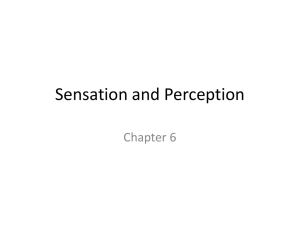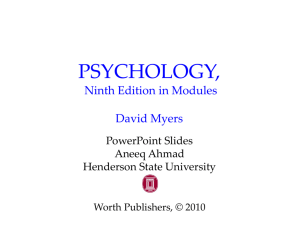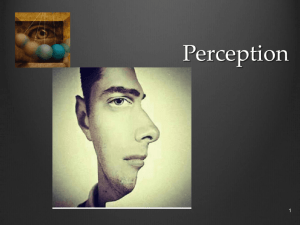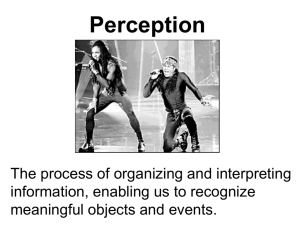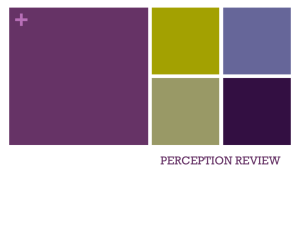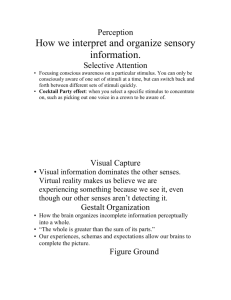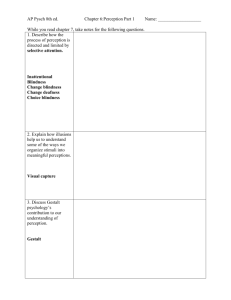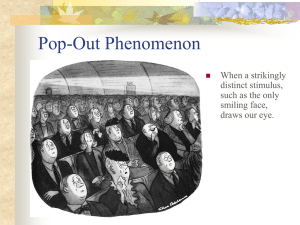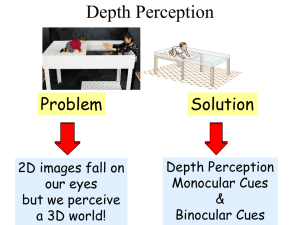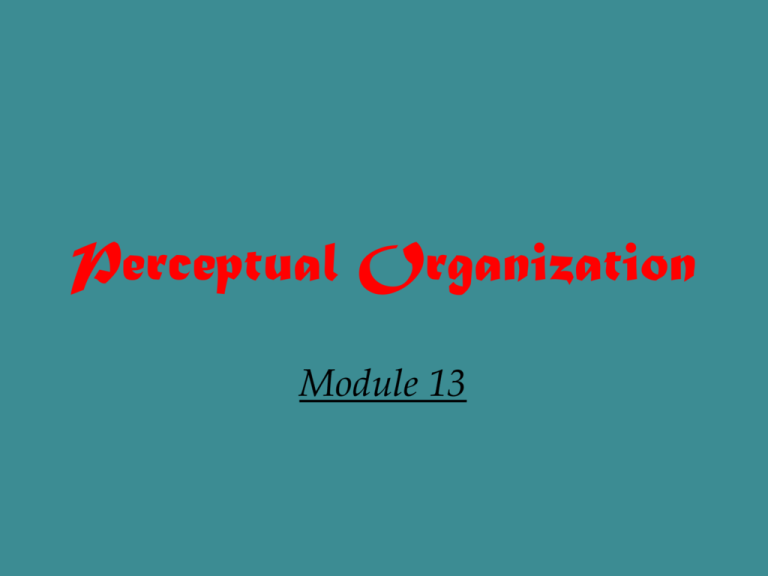
Perceptual Organization
Module 13
TASK OF PERCEPTION
• The task of perception is to extract
sensory input from the environment and
organize it into stable, meaningful
percepts –meaningful product of
perception.
Perceptual Organization
How do we form meaningful perceptions
from sensory information?
We organize it.
Gestalt psychologists showed that a figure
formed a “whole” different from its
surroundings. Said that the whole may
exceed the sum of its parts.
GESTALT
DISCOVERIES
Figure and Ground: Organization of the visual
field into objects (figures) that stand out from their
surroundings (ground).
Time Savings Suggestion, © 2003 Roger Sheperd.
Grouping
After distinguishing the figure from the ground,
our perception needs to organize the figure into
a meaningful form using grouping rules.
LAW of COMMON FATE
• We tend to group similar objects together
that share a common motion or destination
• Ex. Flock of geese, marching band, school
of fish.
LAW OF PRAGNANZ
• Minimum principle of
perception
• We perceive the
simplest pattern as
possible-with the least
amount of effort.
CLOSURE
• Filling in the blanks
• Makes you see
incomplete figures as
wholes by supplying
the missing
segments.
• Does this ring a
______ with you?
Grouping & Reality
Although grouping principles usually help us construct
reality, they may occasionally lead us astray.
Both photos by Walter Wick. Reprinted from GAMES
Magazine. .© 1983 PCS Games Limited Partnership
Depth Perception
Innervisions
Depth perception enables us to judge distances. Gibson and Walk
(1960) suggested that human infants (crawling age) have depth
perception. Even newborn animals show depth perception. Another
psychologist (Bower) found depth perception in infants at only 2 weeks
old (Using 3-D goggles)
Visual Cliff
Binocular Cues-2 Eyes
Retinal disparity: Images from the two eyes differ. Try
looking at your two index fingers when pointing them
towards each other half an inch apart and about 5 inches
directly in front of your eyes. You will see a “finger
sausage” as shown in the inset.
Monocular Cues
Relative Size: If two objects are similar in size, we
perceive the one that casts a smaller retinal image
to be farther away.
Monocular Cues
Interposition: Objects that occlude (block) other
objects tend to be perceived as closer.
Rene Magritte, The Blank Signature, oil on canvas,
National Gallery of Art, Washington. Collection of
Mr. and Mrs. Paul Mellon. Photo by Richard Carafelli.
Monocular Cues
Relative Height: We perceive objects that are higher in our
field of vision to be farther away than those that are lower.
Image courtesy of Shaun P. Vecera, Ph. D.,
adapted from stimuli that appered in Vecrera et al., 2002
Monocular Cues
Relative motion: Objects closer to a fixation point
move faster and in opposing direction to those
objects that are farther away from a fixation point,
moving slower and in the same direction.
Monocular Cues
Linear Perspective: Parallel lines, such as railroad
tracks, appear to converge in the distance. The
more the lines converge, the greater their
perceived distance.
© The New Yorker Collection, 2002, Jack Ziegler
from cartoonbank.com. All rights reserved.
Monocular Cues
Light and Shadow: Nearby objects reflect more light into
our eyes than more distant objects. Given two identical
objects, the dimmer one appears to be farther away.
From “Perceiving Shape From Shading” by Vilayaur
S. Ramachandran. © 1988 by Scientific American, Inc.
All rights reserved.
Perceptual Constancy
Perceiving objects as unchanging even as
illumination and retinal images change.
Color Constancy
Perceiving familiar objects as having consistent
color even when changing illumination filters
the light reflected by the object.
Color Constancy
Size-Distance Relationship
The distant monster (below, left) and the top red
bar (below, right) appear bigger because of
distance cues.
Alan Choisnet/ The Image Bank
From Shepard, 1990
Size-Distance Relationship
Both girls in the room are of similar height.
However, we perceive them to be of different
heights as they stand in the two corners of the
room.
Both photos from S. Schwartzenberg/ The Exploratorium
Ames Room
The Ames room is designed to demonstrate the sizedistance illusion.
Lightness Constancy
The color and brightness of square A and B are the same.

